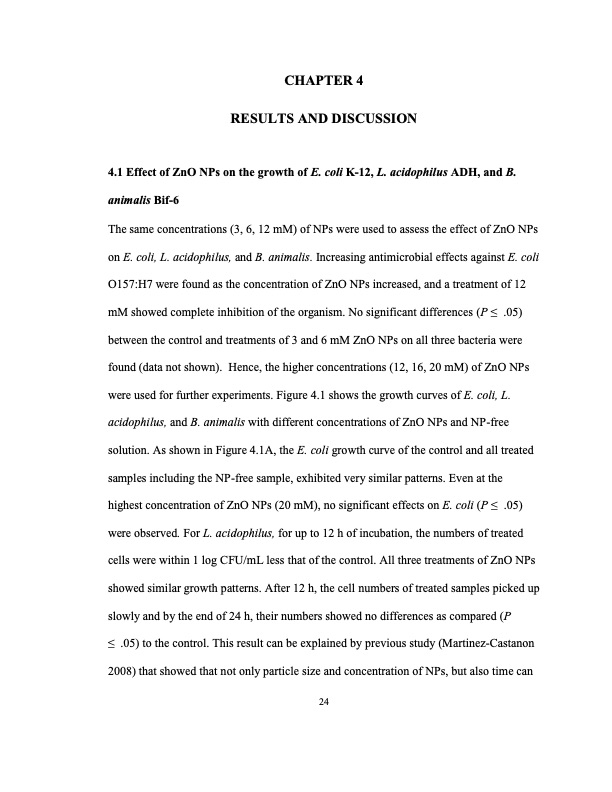
PDF Publication Title:
Text from PDF Page: 035
CHAPTER 4 RESULTS AND DISCUSSION 4.1 Effect of ZnO NPs on the growth of E. coli K-12, L. acidophilus ADH, and B. animalis Bif-6 The same concentrations (3, 6, 12 mM) of NPs were used to assess the effect of ZnO NPs on E. coli, L. acidophilus, and B. animalis. Increasing antimicrobial effects against E. coli O157:H7 were found as the concentration of ZnO NPs increased, and a treatment of 12 mM showed complete inhibition of the organism. No significant differences (P ≤ .05) between the control and treatments of 3 and 6 mM ZnO NPs on all three bacteria were found (data not shown). Hence, the higher concentrations (12, 16, 20 mM) of ZnO NPs were used for further experiments. Figure 4.1 shows the growth curves of E. coli, L. acidophilus, and B. animalis with different concentrations of ZnO NPs and NP-free solution. As shown in Figure 4.1A, the E. coli growth curve of the control and all treated samples including the NP-free sample, exhibited very similar patterns. Even at the highest concentration of ZnO NPs (20 mM), no significant effects on E. coli (P ≤ .05) were observed. For L. acidophilus, for up to 12 h of incubation, the numbers of treated cells were within 1 log CFU/mL less that of the control. All three treatments of ZnO NPs showed similar growth patterns. After 12 h, the cell numbers of treated samples picked up slowly and by the end of 24 h, their numbers showed no differences as compared (P ≤ .05) to the control. This result can be explained by previous study (Martinez-Castanon 2008) that showed that not only particle size and concentration of NPs, but also time can 24PDF Image | ZINC OXIDE AND SILVER NANOPARTICLES ON INTESTINAL BACTERIA

PDF Search Title:
ZINC OXIDE AND SILVER NANOPARTICLES ON INTESTINAL BACTERIAOriginal File Name Searched:
thesis-zinc-oxide-silver-nano.pdfDIY PDF Search: Google It | Yahoo | Bing
Turbine and System Plans CAD CAM: Special for this month, any plans are $10,000 for complete Cad/Cam blueprints. License is for one build. Try before you buy a production license. More Info
Waste Heat Power Technology: Organic Rankine Cycle uses waste heat to make electricity, shaft horsepower and cooling. More Info
All Turbine and System Products: Infinity Turbine ORD systems, turbine generator sets, build plans and more to use your waste heat from 30C to 100C. More Info
CO2 Phase Change Demonstrator: CO2 goes supercritical at 30 C. This is a experimental platform which you can use to demonstrate phase change with low heat. Includes integration area for small CO2 turbine, static generator, and more. This can also be used for a GTL Gas to Liquids experimental platform. More Info
Introducing the Infinity Turbine Products Infinity Turbine develops and builds systems for making power from waste heat. It also is working on innovative strategies for storing, making, and deploying energy. More Info
Need Strategy? Use our Consulting and analyst services Infinity Turbine LLC is pleased to announce its consulting and analyst services. We have worked in the renewable energy industry as a researcher, developing sales and markets, along with may inventions and innovations. More Info
Made in USA with Global Energy Millennial Web Engine These pages were made with the Global Energy Web PDF Engine using Filemaker (Claris) software.
Infinity Turbine Developing Spinning Disc Reactor SDR or Spinning Disc Reactors reduce processing time for liquid production of Silver Nanoparticles.
| CONTACT TEL: 608-238-6001 Email: greg@infinityturbine.com | RSS | AMP |